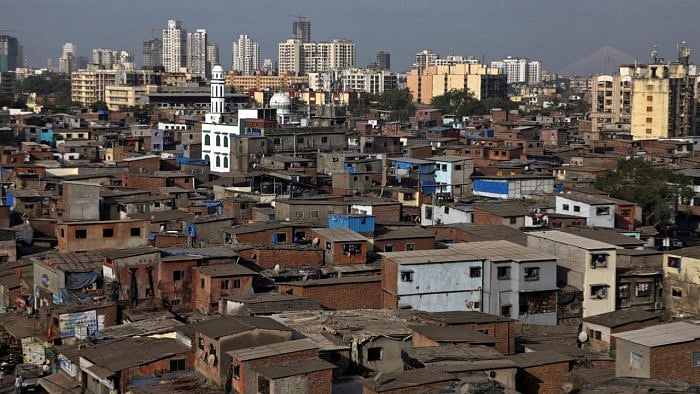
Mumbai's Dharavi slums.
Credit: Reuters File Photo
What do the late Om Puri-starrer Dharavi; the iconic Deewar, starring Amitabh Bachchan and Shashi Kapoor; Rajinikanth’s socio-political action drama Kaala; Mira Nair’s Salaam Bombay; or Danny Boyle’s Oscar-winning Slumdog Millionaire have in common?
They all share the same backdrop: Dharavi — one of Asia’s largest slum clusters. Now, this densely populated settlement, tucked between the Sion-Matunga stations on the Central Railway and the Bandra-Mahim stretch on the Western Railway, is poised for a massive transformation.
Last month, Maharashtra Chief Minister Devendra Fadnavis approved the Dharavi Redevelopment Master Plan, a colossal project with an investment of a whopping Rs 95,790 crore.
The project will be executed by Navbharat Mega Developers Private Ltd (NMDPL), a special purpose vehicle (SPV) formed between the Government of Maharashtra—through the Dharavi Redevelopment Project (DRP)/Slum Rehabilitation Authority (SRA)—and the Adani Group. Spread across 2.1 sq km and home to more than seven lakh residents, Dharavi has one of the highest population densities in the world. Redeveloping it is nothing short of a herculean task.
According to Fadnavis, this historic project aims to preserve the essence of Dharavi while unlocking new possibilities for the community in particular and the city in general.
“Dharavi’s redevelopment will ensure it does not lose its soul. Dharavi is not just a locality—it is a vibrant micro-economy powered by skilled labour, artisans, micro-enterprises, and underprivileged communities. It is essential that redevelopment efforts retain this spirit while creating opportunities for the future. We have issued clear directives to ensure the voices and aspirations of all citizens are integrated into the plan. The goal is to maintain Dharavi’s socio-cultural identity while striking a balance between progress and preservation,” said Fadnavis, who heads the BJP-led Maha Yuti government.
Deputy Chief Minister Eknath Shinde, who also holds the urban development portfolio and serves as the Guardian Minister of Mumbai City, was present at the announcement, along with DRP CEO S V R Srinivas.
Fadnavis’ remarks come amid mounting criticism of the project, with the opposition Maha Vikas Aghadi (MVA) targeting Prime Minister Narendra Modi over the involvement of the Adani Group.
On March 16, 2024, just ahead of the Lok Sabha polls, Congress leader Rahul Gandhi—now the Leader of the Opposition in the Lok Sabha—concluded his 6,700-km, 66-day Bharat Jodo Nyay Yatra in Dharavi, joined by his sister and Congress General Secretary Priyanka Gandhi, now the MP from Wayanad.
Dharavi remained a flashpoint during both the 2024 Lok Sabha and Vidhan Sabha elections, with the Congress and Uddhav Thackeray-led Shiv Sena (UBT) vocally opposing various project conditions of the redevelopment plan.
One of their key demands: that beneficiaries be provided homes of at least 500 sq ft.
“The dumping ground and salt pan lands are being given away to the Adani Group for housing Dharavi residents. Where is the humanity in this?” asked Worli MLA Aaditya Thackeray. “When our government wanted to shift the Metro car shed from Aarey to save forests, the central government blocked it. But here, the Adani Group is being gifted Mumbai land almost free of cost. The BrihanMumbai Municipal Corporation didn’t want to part with the Deonar dumping ground, yet the Adani Group used its proximity to the government to acquire it. The BMC will clean that land at the public’s expense and then hand it over to Adani — citizens will foot the bill through a new garbage tax.”
Mumbai North Central MP Varsha Gaikwad, a former Dharavi MLA, slammed the Fadnavis dispensation for giving away land to the developer: “Like his political masters, the Dharavi CEO seems to have mastered the art of deception and diversion. Why is the ‘Adani Sarkar’ running away from public scrutiny over the Dharavi Master Plan? Why is a nine-year-old planning proposal — now outdated due to substantial modifications — being used to sidestep the mandatory requirement of inviting public suggestions and objections? This is a clear violation of the MRTP Act. Why has there been no public consultation on what is essentially Adani’s Dharavi Vinash Plan? Why should the right of appeal be denied to Dharavi residents deemed ‘ineligible’ in the ongoing survey? The CEO misleads the public by equating this project with standard slum redevelopment projects.”
However, a DRP official countered this criticism: “The 2022 plan offers 350 sq ft homes to eligible residents — 17% larger than those provided under the 2018 tender or any other slum rehabilitation projects — ensuring better living space. All Dharavi residents, regardless of eligibility, will now have access to private toilets, kitchens with running water, and electricity — basic amenities that weren’t uniformly guaranteed under previous schemes.”
The official added that those who settled on the ground floor between 2000 and 2011 will be eligible for housing under the PM Awas Yojana (PMAY). “Even those who settled after 2011 or live on upper floors will be provided housing, although outside Dharavi. So, instead of 60,000-70,000 tenements, this plan aims to settle 200,000 tenements and the 1.2 million Dharavikars who live in them,” the official said. “We have brought in top global planners, architects, and designers for this project. Every home will have its own toilet, bathroom and kitchen. Families will enjoy privacy, dignity, and legal ownership, as homes will be registered in the names of beneficiaries.”
Amid the quicksand of contradictions that is Dharavi, the central challenge of identifying rightful claimants continues to linger. The redevelopment will also absorb a fragment of Mumbai’s layered history: the Riwa Fort —also known as Kala Qilla or Black Fort—built by Gerald Aungier, the first governor of Bombay (1669–1677). Once part of the larger Bombay Castle complex, it marked the northern portion of British-held Bombay in the 17th century.